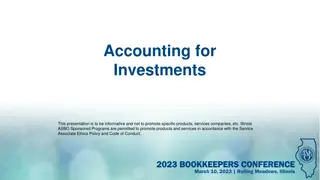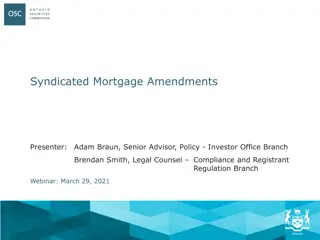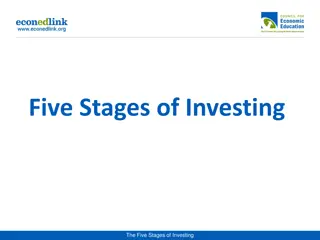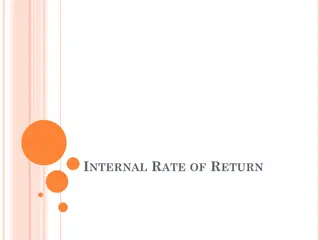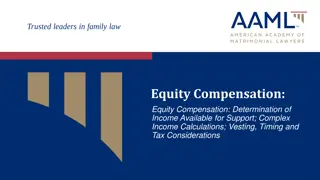Understanding Investments: A Comprehensive Overview by Mr. Vinoth Kumar J, Assistant Professor
Mr. Vinoth Kumar J, an Assistant Professor at St. Joseph's College, dives into the world of investments, explaining the meaning, definition, and classification of investments. He covers financial products like equities, mutual funds, real estate, and more, providing insights into both financial and economic investment strategies.
Download Presentation

Please find below an Image/Link to download the presentation.
The content on the website is provided AS IS for your information and personal use only. It may not be sold, licensed, or shared on other websites without obtaining consent from the author. Download presentation by click this link. If you encounter any issues during the download, it is possible that the publisher has removed the file from their server.
E N D
Presentation Transcript
SECURITY ANALYSIS Mr. Vinoth Kumar. J Assistant Professor, Department of Commerce, St. Joseph s College (Autonomous), Tiruchirappalli 620 002.
Investments - Meaning Investment is an activity that is engaged in by people who have savings i.e investments are made from savings, or in other words people invest their savings but all savings are not investment. Investment is putting money into something with the expectation that it will generate income or the value will appreciate in future or profit. 5
Investments - Definition An Investment is a commitment of funds made in the expectation of some positive rate of returns. If the investment is properly undertaken, the returns will commensurate with the risk the investor assumes . Donald E. Fischer and Donald J. Jordan. 6
Investments - Definition According to Dr. Kevin Investment is an activity that is engaged by people who have savings, i.e. investments are made from savings, or in other words, people invest their savings. But all savers are not investors. Investment is an activity which is different from saving. It means many things to many persons. 7
Investments - Classification 1. Financial Investment: It Means employment of funds in the form of assets with the object of earning additional income or appreciation in the value of investment in future. Assets which are the subject matter of investment may be varying between safe and risky ones. 8
Financial Products Equities Post Office Schemes RBI Bonds Fixed Deposits Insurance Investment Mutual Funds Forex Real Estate Gold 9
Investments - Classification 2. Economic Investment: Investment means the net addition to the economy s capital stock which consists of goods and services, that are used in the production of other goods and services. 10
Economic Investment Buildings Investment Inventories Equipment 11
Investments Objectives Hedge against Inflation Capital Appreciation Return Risk Safety Liquidity Tax Planning 12
Investments Objectives Return: All investments are characterized by the expectation of a return. In fact, investments are made with the primary objective of deriving a return. The return may be received in the form of yield plus capital appreciation. The difference between the sale price and the purchase price is capital appreciation. The dividend or interest received from the investment is the yield. The return from an investment depends upon the nature of the investment, the maturity period and a host of other factors. Return = Capital Gain + Yield (interest, dividend etc.) 13
Investments Objectives Capital Appreciation: Capital appreciation is a rise in the value of an asset based on a rise in market price. It occurs when the asset invested commands a higher price in the market than an investor originally paid for the asset. The capital appreciation portion of the investment includes all of the market value exceeding the original investment or cost basis. 14
Investments Characteristics Risk: Risk refers to the loss of principal amount of an investment. The investment maturity period is longer - investor will take larger risk. Government or Semi Government bodies are issuing securities which have less risk. In the case of the debt instrument or fixed deposit, the risk of above investment is less due to their secured and fixed interest payable on them. 15
Investments Characteristics Risk: In the case of ownership instrument like equity or preference shares, the risk is more due to their unsecured nature and variability of their return and ownership character. The risk of degree of variability of returns is more in the case of ownership capital compare to debt capital. The tax provisions would influence the return of risk. 16
Investments Characteristics Safety: Capital is the certainty of return without loss of money or it will take time to retain it. If investor prefers less risk securities, he chooses Government bonds. In the case, investor prefers high rate of return investor will choose private Securities and Safety of these securities is low. Investor prefers safety about his capital. 17
Investments Characteristics Liquidity: Liquidity refers to an investment ready to convert into cash position. In other words, it is available immediately in cash form. Liquidity means that investment is easily realizable, saleable or marketable. When the liquidity is high, then the return may be low. 18
Investments Characteristics Hedge Against Inflation: Inflation has the effect of rising prices with a falling standard of living. It may erode the value of money which has been invested in assets. The investor seeks to invest in such assets which give him adequate return as a safeguard against any possible erosion in investment. 19
Investments Characteristics Time: It offers several different courses of action. Time period depends on the attitude of the investor who follows a buy and hold policy. As time moves on, analysis believes that conditions may change and investors may revaluate expected returns and risk for each investment. 20
Thank You 21


